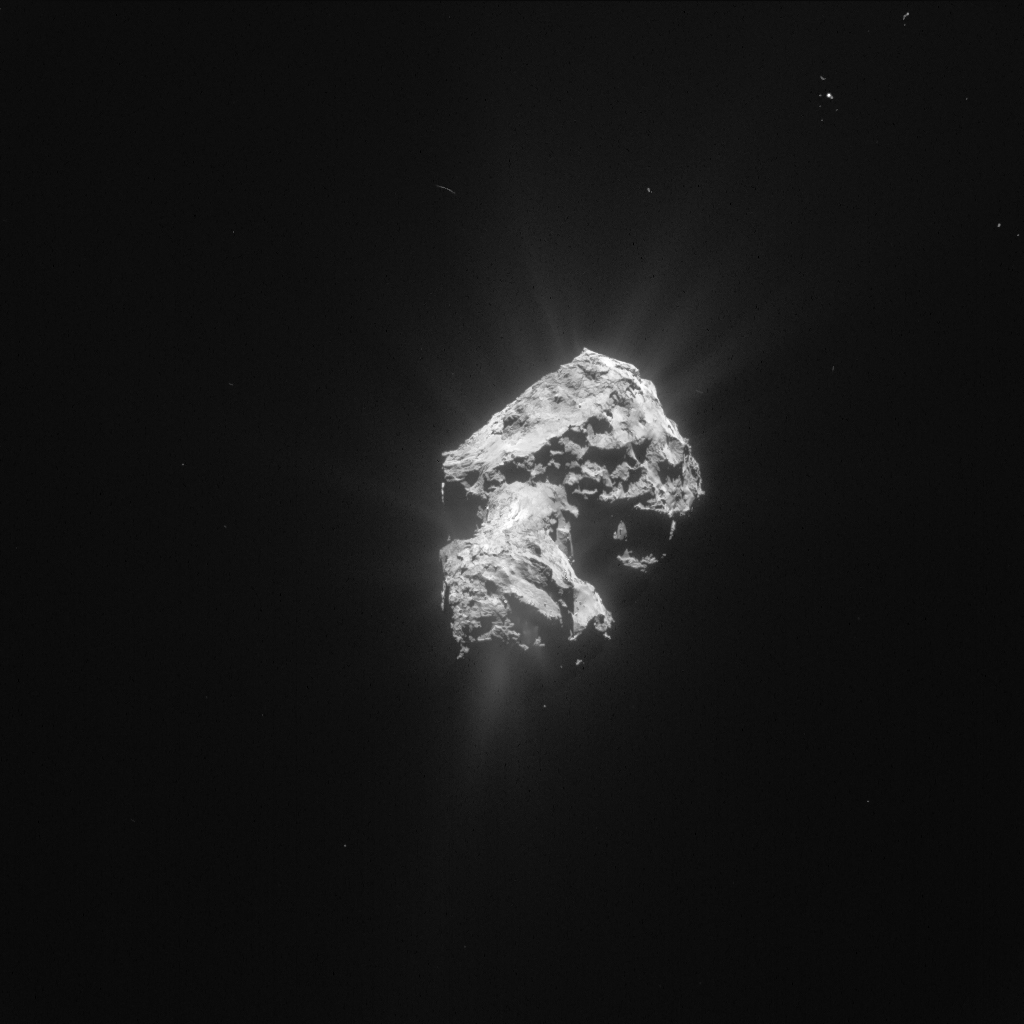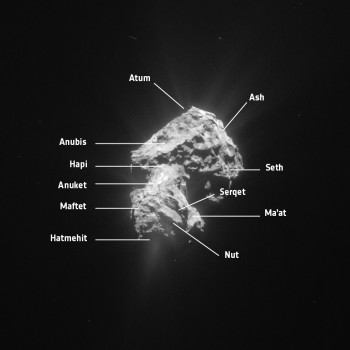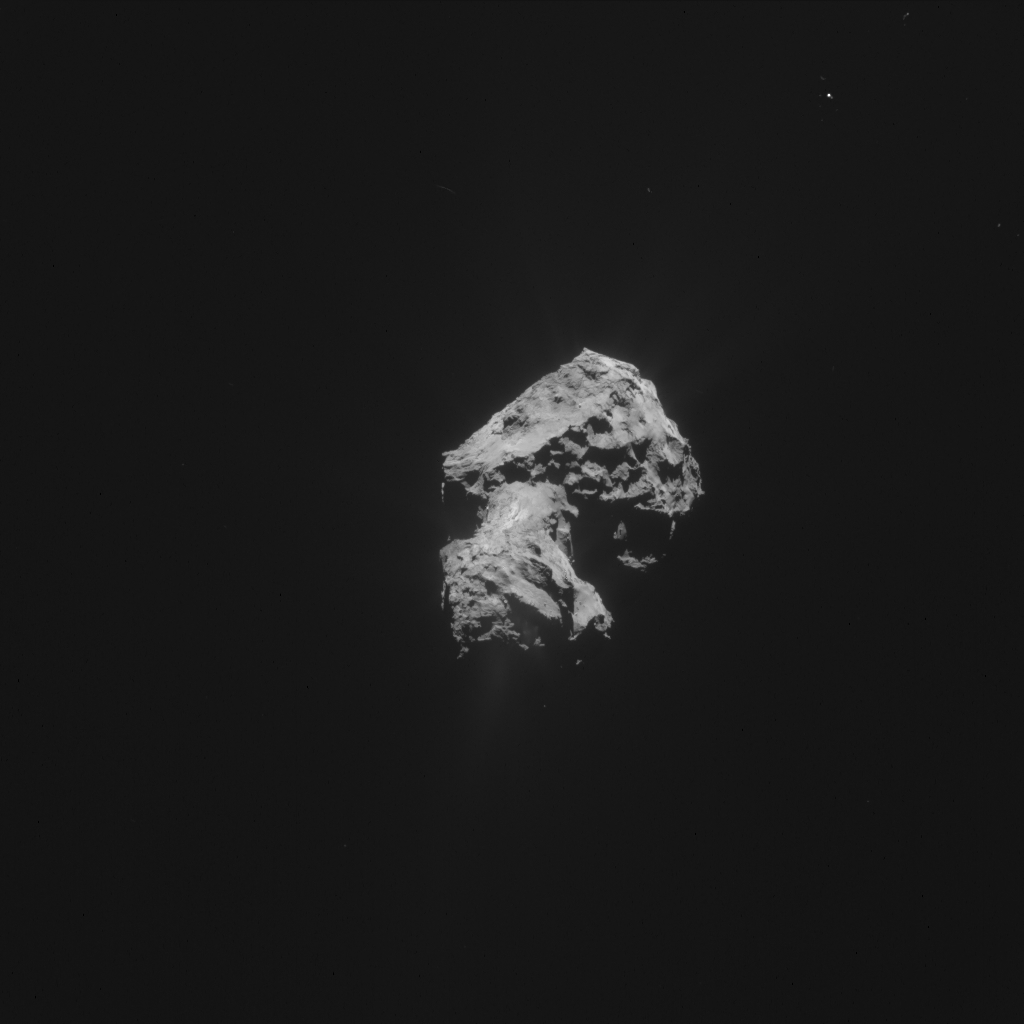This image of Comet 67P/Churyumov-Gerasimenko was taken by Rosetta’s NAVCAM on 20 May at a distance of 163.6 km from the comet centre. It is a single frame image with a resolution of 13.9 m/pixel, and measures 14.3 km across. The intensities and contrast have been adjusted to emphasise the activity of the comet.

Processed image of Comet 67P/C-G taken by Rosetta’s NAVCAM on 20 May 2015. Credits: ESA/Rosetta/NavCam – CC BY-SA IGO 3.0
 In this orientation, perhaps the most striking observation is the activity seen close to Hatmehit, the circular depression on the comet’s small lobe. There also appears to be activity associated with the Nut region, which lies below Serqet in this orientation. In both cases, the activity stands out against the shadowed portions of the comet in this area.
In this orientation, perhaps the most striking observation is the activity seen close to Hatmehit, the circular depression on the comet’s small lobe. There also appears to be activity associated with the Nut region, which lies below Serqet in this orientation. In both cases, the activity stands out against the shadowed portions of the comet in this area.
On the large lobe, the comet is oriented with the relatively smooth face of Anubis towards the top left, making a distinct boundary with the neighbouring rugged Seth region to the right.
In this view the comet also shows off the transition between the two lobes, with Anuket on the small lobe merging into Hapi at the neck.
The original 1024 x 1024 pixel image is provided below:










Discussion: 13 comments
Fantastic picture Emily, thank you for picking it out.
I have been waiting to see this shot from the moment we were able to pick out the large crater from the early photographs. It was so obviously a sight of erosion & not collision. If only the science team could detail the different types of erosion and where and how it happens.
Fabulous picture – looks like its got its own ion motor and is camera shy so had decided to rocket into the distance.
Regards
Dave: I like your rocket view.
Kamal
Hi Dave,
I beg to differ. I find it obvious that Hatmehit is neither from collision nor erosion. It is from a gross mass wasting event – A missing slab.
See
https://scute1133site.wordpress.com/2015/01/25/180/
Hi Marco,
You may be right Marco, it was not a scientifically drawn conclusion.
Just from the first time i saw the hole I was expecting a jet of the same size at some point.
Of course I accept that any number of events could of created it, and that the Jet may be a secondary event.
However it suits my imagination for the time being.
regards
Hatmehit will become a massive jet. It seems that the jets are reoccurring in a similar location as prior visits close to the sun. The largest depressions will host the most activity, which is why the neck region jets appeared first. I really hope ESA will remove the filter of researcher’s bias and take a look at these observations at face-value. Too much faith in prior beliefs is going to lead to “dark ice” or an equivalent needed to sublimate from pockets that don’t exist.
Well said Ross. I agree with you 100% about the preconditioning and the “dark ice” danger. There are signs of bypassing the critical issues, such as the nature and properties of the jets. Your prediction about the effect of repeated jet activity in the same place could be correct. It is plausible that the effect of surface profile on charge concentration could be repeated with successive orbits. I wonder however if some of the major features, particularly the large craters, were formed by the much larger electric discharge which separated the comet rock from its parent body in the first place, or indeed during subsequent close encounters with other solar system bodies.
It is by the way obvious that we are looking in this image once again at an intrinsically illuminated jet emanating from a shaded region. Is this prompting any investigation I wonder.
originaljohn: “Is this prompting any investigation I wonder”.
Based on this confused “electric universe” nonsense certainly not.
But there may be scientific reasons, since the goal is to maximize science return.
No confusion Gerald. The hypothesis has been clearly and rationally presented by all.
Whether it is nonsense or not is an opinion, not supported by any factual data.
I would think there are impeccable scientific reasons for a detailed investigation of the jets, in both shaded and sunlit regions. One would be to determine beyond dispute the nature of the jets, the clear contenders being combustion/ plasma discharge and gas sublimed from ice, issuing under pressure, although there is no actual reason to believe there is any ice.
A newspaper with printed large black letters is still mainly made of paper.
Rubber wheels colored black by soot are still mainly made of rubber.
Black cotton clothes are still mainly made of cotton.
Black liquid ink is still mainly made of water.
Ice covered with black iron sulfide dust is still mainly made of ice.
“Too much faith in prior beliefs is going to lead to” electrical comet sects.
“I really hope ESA will remove the filter of” electric universe proponents”‘ bias”. (for the sake of the electric universe proponents)
@ Gerald
“A newspaper with printed large black letters is still mainly made of paper.
Rubber wheels colored black by soot are still mainly made of rubber.
Black cotton clothes are still mainly made of cotton.
Black liquid ink is still mainly made of water.
Ice covered with black iron sulfide dust is still mainly made of ice.”
Here again, Gerald, your attempted comparison between four MAN-MADE ARTIFACTS on the one hand and a little-understood NATURAL object on the other constitutes a logical fallacy (see my previous comment on the “Ultraviolet study reveals surprises in comet coma” thread regarding your comparison between hourglasses and yoyos on the one hand and hourglass-SHAPED celestial bodies on the other : https://blogs.esa.int/rosetta/2015/06/02/ultraviolet-study-reveals-surprises-in-comet-coma/#comment-469395).
If it is really Comet 67P you are describing when you say that “Ice covered with black iron sulfide dust is still mainly made of ice”, perhaps you could actually provide some actual scientific evidence for your assertion, since so far not a scrap of evidence has been provided by the Rosetta findings themselves. (Even the existence of “water” allegedly “spewing” from the surface has been severely called into question by the “surprising” discovery of considerable quantities of H and O atoms/ions in the immediate vicinity of the surface, with no direct detection of H2O). Your “mainly made of ice” assertion remains a mere unfounded ASSUMPTION and there is nothing that your ill-chose, irrelevant comparisons can do to change that fact.
A little more scientific rigour, please.
Then of course there are those who demand explanations of lightening, sprites etc which are utterly irrelevant to the conditions on 67P, but can’t provide a basic description of the electrical processes it is claimed operate at any level at all.
The English phrase ‘the pot calling the kettle black’ seems particularly apposite 🙂
To a degree, the difficulty in seeing ice has surprised everyone. *IF* a remotely credible alternative to its existence was proposed, I think everyone would jump on it immediately. But no such alternative exists; the solar wind explanations have so many issues they are simply not credible; FAR more problems than, for the moment and faut de mieux, believing in hidden ice. (Which does, as Gerald was trying to point out, take very little material to hide.)
THOMAS: “Your “mainly made of ice” assertion remains a mere unfounded ASSUMPTION”
Even you can easily duplicate this in your kitchen, e.g. with soot and ice.
Ice + black pigment = black-colored ice.
Your “man-made” hering doesn’t change the result.
Thankyou!